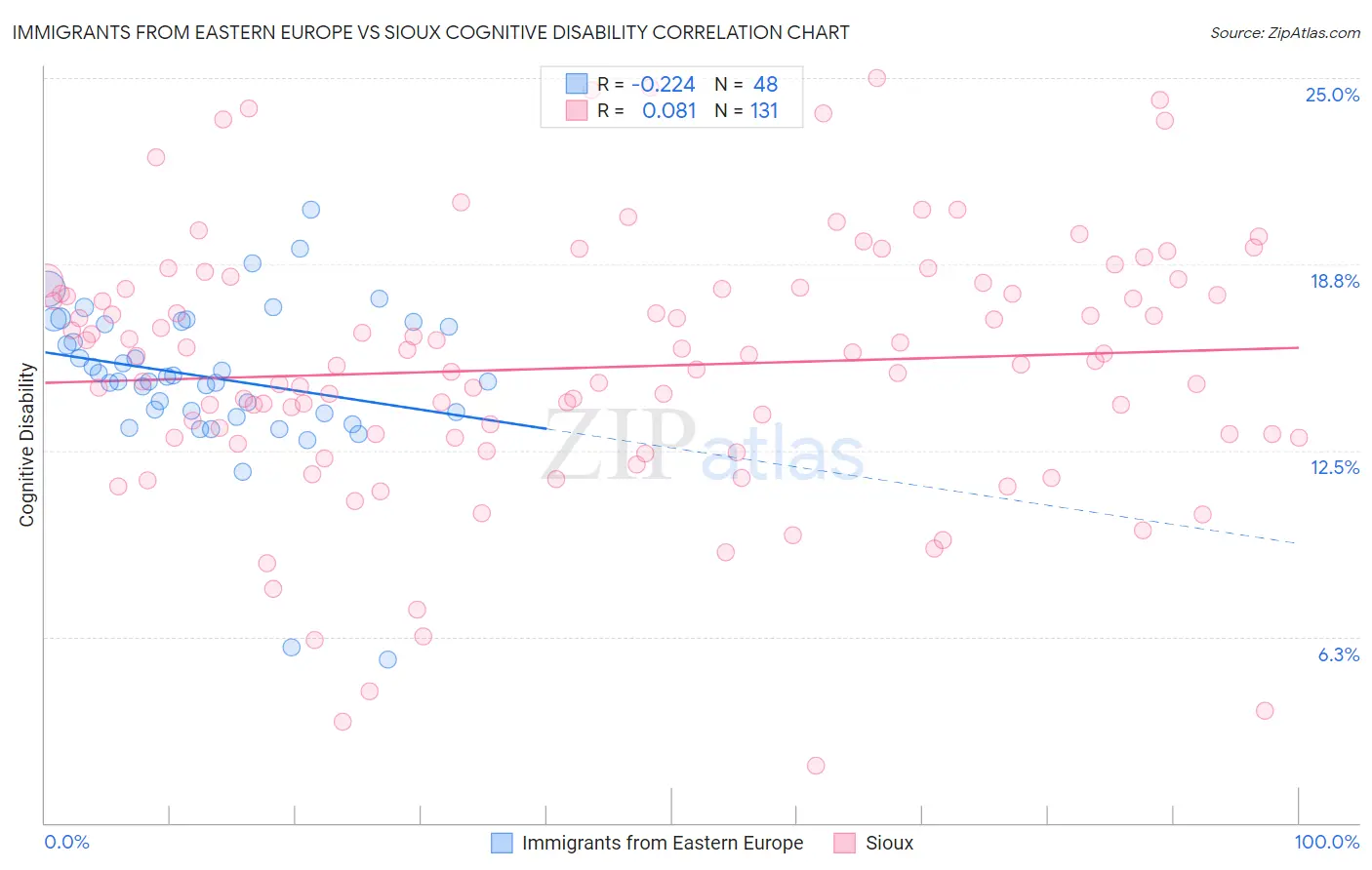Immigrants from Eastern Europe vs Sioux Cognitive Disability
COMPARE
Immigrants from Eastern Europe
Sioux
Cognitive Disability
Cognitive Disability Comparison
Immigrants from Eastern Europe
Sioux
16.5%
COGNITIVE DISABILITY
99.9/ 100
METRIC RATING
38th/ 347
METRIC RANK
17.3%
COGNITIVE DISABILITY
48.6/ 100
METRIC RATING
179th/ 347
METRIC RANK
Immigrants from Eastern Europe vs Sioux Cognitive Disability Correlation Chart
The statistical analysis conducted on geographies consisting of 475,806,122 people shows a weak negative correlation between the proportion of Immigrants from Eastern Europe and percentage of population with cognitive disability in the United States with a correlation coefficient (R) of -0.224 and weighted average of 16.5%. Similarly, the statistical analysis conducted on geographies consisting of 234,153,820 people shows a slight positive correlation between the proportion of Sioux and percentage of population with cognitive disability in the United States with a correlation coefficient (R) of 0.081 and weighted average of 17.3%, a difference of 5.0%.

Cognitive Disability Correlation Summary
| Measurement | Immigrants from Eastern Europe | Sioux |
| Minimum | 5.5% | 1.9% |
| Maximum | 20.6% | 25.0% |
| Range | 15.1% | 23.1% |
| Mean | 14.9% | 15.3% |
| Median | 14.9% | 15.5% |
| Interquartile 25% (IQ1) | 13.8% | 12.9% |
| Interquartile 75% (IQ3) | 16.8% | 17.9% |
| Interquartile Range (IQR) | 3.0% | 5.0% |
| Standard Deviation (Sample) | 2.7% | 4.4% |
| Standard Deviation (Population) | 2.6% | 4.4% |
Similar Demographics by Cognitive Disability
Demographics Similar to Immigrants from Eastern Europe by Cognitive Disability
In terms of cognitive disability, the demographic groups most similar to Immigrants from Eastern Europe are Slovene (16.5%, a difference of 0.020%), Bolivian (16.5%, a difference of 0.070%), Immigrants from Belarus (16.5%, a difference of 0.090%), Cuban (16.5%, a difference of 0.090%), and Hungarian (16.5%, a difference of 0.10%).
| Demographics | Rating | Rank | Cognitive Disability |
| Immigrants | Romania | 99.9 /100 | #31 | Exceptional 16.4% |
| Immigrants | Israel | 99.9 /100 | #32 | Exceptional 16.4% |
| Italians | 99.9 /100 | #33 | Exceptional 16.4% |
| Russians | 99.9 /100 | #34 | Exceptional 16.4% |
| Slovaks | 99.9 /100 | #35 | Exceptional 16.4% |
| Greeks | 99.9 /100 | #36 | Exceptional 16.4% |
| Slovenes | 99.9 /100 | #37 | Exceptional 16.5% |
| Immigrants | Eastern Europe | 99.9 /100 | #38 | Exceptional 16.5% |
| Bolivians | 99.9 /100 | #39 | Exceptional 16.5% |
| Immigrants | Belarus | 99.9 /100 | #40 | Exceptional 16.5% |
| Cubans | 99.9 /100 | #41 | Exceptional 16.5% |
| Hungarians | 99.9 /100 | #42 | Exceptional 16.5% |
| Immigrants | Canada | 99.8 /100 | #43 | Exceptional 16.5% |
| Macedonians | 99.8 /100 | #44 | Exceptional 16.5% |
| Immigrants | Europe | 99.8 /100 | #45 | Exceptional 16.5% |
Demographics Similar to Sioux by Cognitive Disability
In terms of cognitive disability, the demographic groups most similar to Sioux are Ute (17.3%, a difference of 0.010%), Spanish (17.3%, a difference of 0.010%), Shoshone (17.3%, a difference of 0.020%), Tsimshian (17.3%, a difference of 0.030%), and Laotian (17.3%, a difference of 0.040%).
| Demographics | Rating | Rank | Cognitive Disability |
| Immigrants | Turkey | 56.7 /100 | #172 | Average 17.2% |
| Immigrants | Northern Africa | 50.2 /100 | #173 | Average 17.3% |
| Laotians | 50.0 /100 | #174 | Average 17.3% |
| Tsimshian | 49.8 /100 | #175 | Average 17.3% |
| Shoshone | 49.2 /100 | #176 | Average 17.3% |
| Ute | 49.1 /100 | #177 | Average 17.3% |
| Spanish | 48.9 /100 | #178 | Average 17.3% |
| Sioux | 48.6 /100 | #179 | Average 17.3% |
| Pakistanis | 43.9 /100 | #180 | Average 17.3% |
| Immigrants | Guyana | 42.9 /100 | #181 | Average 17.3% |
| Arabs | 42.8 /100 | #182 | Average 17.3% |
| Spaniards | 40.3 /100 | #183 | Average 17.3% |
| Crow | 39.1 /100 | #184 | Fair 17.3% |
| Afghans | 38.2 /100 | #185 | Fair 17.3% |
| Cambodians | 35.9 /100 | #186 | Fair 17.3% |